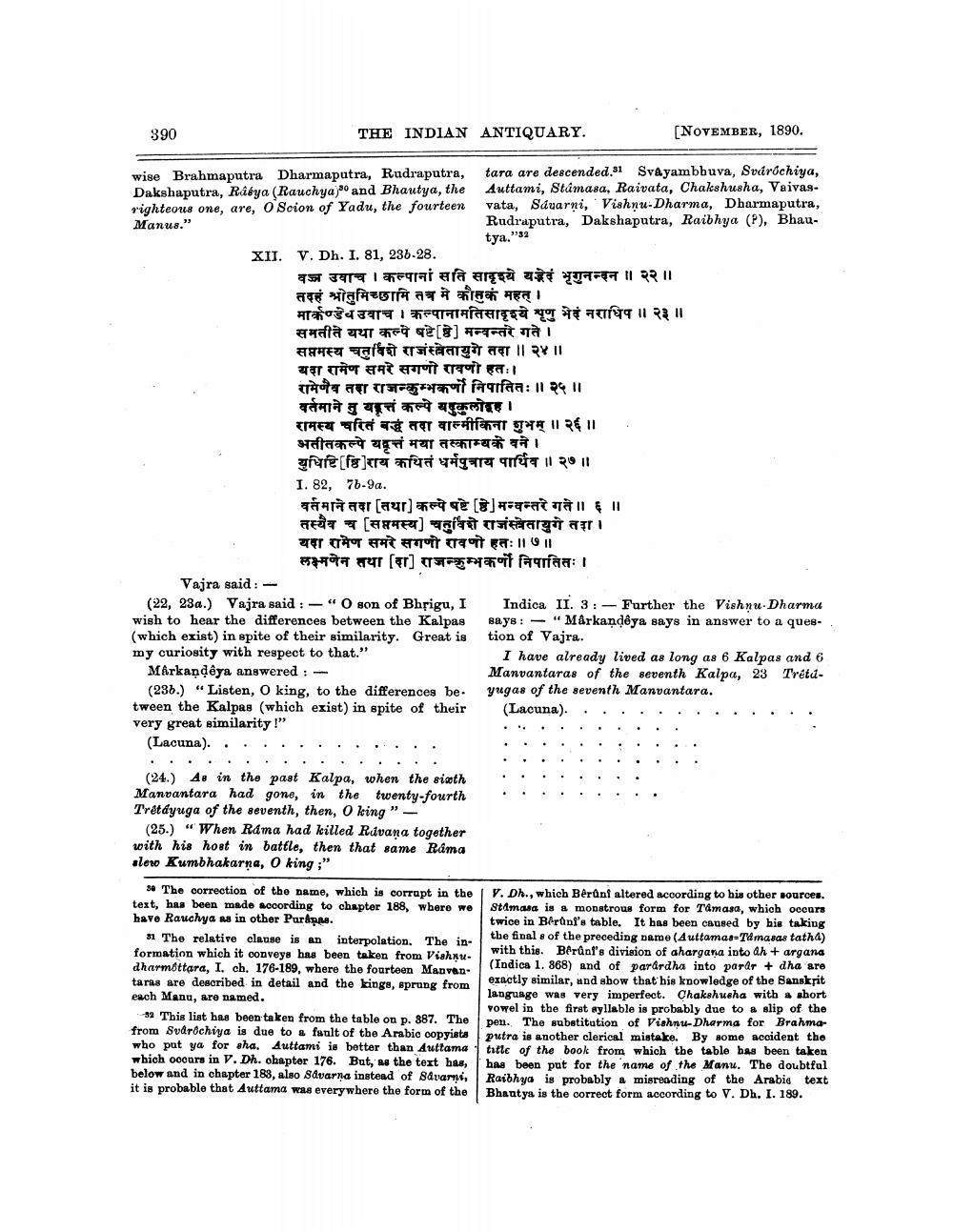________________
390
THE INDIAN ANTIQUARY.
wise Brahmaputra Dharmaputra, Rudraputra, Dakshaputra, Râéya (Rauchya and Bhautya, the righteous one, are, O Scion of Yadu, the fourteen
Manus."
XII. V. Dh. I. 81, 236-28.
वज्ञ उवाच । कल्पानां सति सादृश्ये यद्भेदं भृगुनन्दन ।। २२ ।। तदहं श्रोतुमिच्छामि तत्र मे कौतुकं महत् । मार्कण्डेय उवाच । कल्पानामतिसादृश्ये शृणु भेदं नराधिप ।। २३ ।। समतीते यथा कल्पे षष्टे [ष्ठे] मन्वन्तरे गते ।
सप्तमस्य चतुर्विशे राजंस्त्रेतायुगे तदा ।। २४ ।। यश रामेण समरे सगणो रावणो हतः । रामेणैव तदा राजन्कुम्भकर्णो निपातितः ।। २५ ।। वर्तमाने तु बहु कल्पे
रामस्य चरितं बद्धं तदा वाल्मीकिना शुभम् ।। २६ ।। अतीतकल्पे यद्वृत्तं मया तस्काम्बके वने ।
पिटि ([[]] कथितं धर्मपुजा पार्थिव ।। २० ।। I. 82, 7b-9a.
वर्तमाने तदा [तथा ] कल्पे षष्टे [ष्ठे ] मन्वन्तरे गते ।। ६ ।। medy (www) wy/hvit crafsiargir mer यदा रामेण समरे सगणी रावणो हतः ॥ ७ ॥ लक्ष्मणेन तथा [दा] राजन्कुम्भकर्णो निपातितः ।
Vajra said: (22, 23a.) Vajra said: -"O son of Bhrigu, I wish to hear the differences between the Kalpas (which exist) in spite of their similarity. Great is my curiosity with respect to that."
Markaṇḍêya answered: -
(236.) "Listen, O king, to the differences be. tween the Kalpas (which exist) in spite of their very great similarity!"
(Lacuna).
(24.) As in the past Kalpa, when the sixth Manvantara had gone, in the twenty-fourth Trêtayuga of the seventh, then, O king"
(25.) "When Rama had killed Ravana together with his host in battle, then that same Rama slew Kumbhakarna, O king;"
30 The correction of the name, which is corrupt in the text, has been made according to chapter 188, where we have Rauchya as in other Puranas.
[NOVEMBER, 1890.
tara are descended.31 Svayambhuva, Sváróchiya, Auttami, Stâmasa, Raivata, Chakshusha, Vaivasvata, Sduarni, Vishnu-Dharma, Dharmaputra, Rudraputra, Dakshaputra, Raibhya (P), Bhautya."32
31 The relative clause is an interpolation. The information which it conveys has been taken from Vishnudharmottara, I. ch. 176-189, where the fourteen Manvantaras are described in detail and the kings, sprung from each Manu, are named.
32 This list has been taken from the table on p. 887. The from Svarôchiya is due to a fault of the Arabic copyists who put ya for sha. Auttami is better than Auttama which occurs in V. Dh. chapter 176. But, as the text has, below and in chapter 183, also Savarna instead of Savarni, it is probable that Auttama was everywhere the form of the
Indica II. 3 Further the Vishnu Dharma says: "Markaṇḍêya says in answer to a question of Vajra.
I have already lived as long as 6 Kalpas and 6 Manvantaras of the seventh Kalpa, 23 Trétáyugas of the seventh Manvantara.
(Lacuna).
V. Dh., which Bêrûnî altered according to his other sources. Stamasa is a monstrous form for Tamasa, which occurs twice in Berûnî's table. It has been caused by his taking the finals of the preceding name (Auttamas-Tamasas tatha) with this. Bêrünf's division of ahargana into ah + argana (Indica 1. 368) and of parårdha into parar + dha are exactly similar, and show that his knowledge of the Sanskrit language was very imperfect. Chakshusha with a short vowel in the first syllable is probably due to a slip of the pen. The substitution of Vishnu-Dharma for Brahmaputra is another clerical mistake. By some accident the title of the book from which the table has been taken has been put for the name of the Manu. The doubtful Raibhya is probably a misreading of the Arabie text Bhantya is the correct form according to V. Dh. I. 189.




